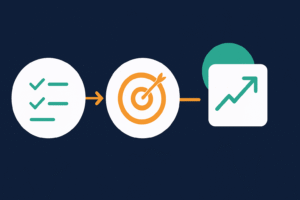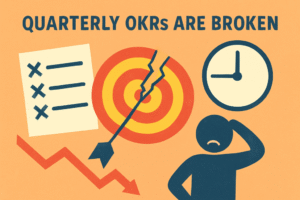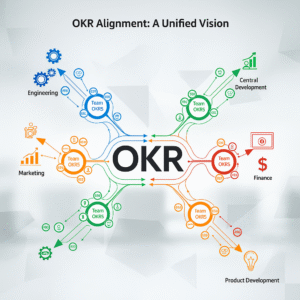Delivering complex initiatives in large, dynamic organizations often feels like navigating through fog: without clear, meaningful metrics, leaders struggle to maintain visibility, and teams risk drifting off course. To consistently succeed, organizations must measure progress purposefully and clearly. By adopting essential metrics, leaders gain actionable insights, enabling better decision-making, stronger team alignment, and more reliable outcomes.
Below are critical metrics for portfolio excellence, including practical examples, insights into their significance, and actionable ways to integrate them into organizational decision-making.
1. Value Delivery Metrics
Portfolio success ultimately hinges on the value delivered, not merely tasks completed. Measuring true business value provides clarity on whether initiatives positively impact strategic goals.
Business Value Realized
- What it tells you: Tangible business outcomes from initiatives, such as increased revenue, reduced costs, or improved customer satisfaction.
- Practical Example: An e-commerce platform tracking revenue growth from new features identifies low-impact initiatives and reallocates investments to higher-value areas.
- Decision-making: Use this metric to prioritize initiatives consistently delivering high value, and reconsider projects delivering minimal measurable outcomes.
Strategic Alignment Score
- What it tells you: The extent initiatives support strategic organizational goals.
- Practical Example: A financial services firm scores initiatives based on strategic themes, ensuring resources align with corporate priorities like digital transformation.
- Decision-making: Guide investments toward high-alignment projects, ensuring coherence between strategy and execution.
2. Flow Metrics
Flow metrics assess the efficiency and speed of work moving through delivery systems, spotlighting bottlenecks and improving process efficiency.
Lead Time & Cycle Time
- What it tells you: The speed and efficiency of workflows, revealing potential bottlenecks.
- Practical Example: A software team discovers testing phases consistently delay releases; addressing this reduces lead time significantly.
- Decision-making: Identify and target delays or inefficiencies, enabling quicker and more predictable delivery.
Throughput
- What it tells you: Volume of value-adding work completed within a specific timeframe.
- Practical Example: An IT department stabilizes throughput by introducing agile practices, improving resource planning and predictability.
- Decision-making: Leverage historical throughput data to set realistic expectations and maintain a sustainable pace.
Flow Efficiency
- What it tells you: Proportion of time spent actively working versus waiting.
- Practical Example: An analytics group identifies approval delays as a significant inefficiency; streamlining processes dramatically boosts productivity.
- Decision-making: Focus on minimizing waiting periods to enhance overall operational efficiency.
3. Quality and Stability Metrics
Quality metrics ensure the balance between speed and reliability, highlighting issues early and ensuring consistent quality standards.
Change Failure Rate
- What it tells you: Frequency of deployment-related issues, indicating stability of releases.
- Practical Example: A telecom company improves deployment reliability by enhancing pre-release testing, reducing incidents significantly.
- Decision-making: Strengthen quality assurance processes to ensure reliability and reduce the likelihood of costly rework.
Mean Time to Recover (MTTR)
- What it tells you: Team responsiveness in resolving issues.
- Practical Example: An enterprise reduces MTTR by implementing better monitoring tools and clear incident management protocols.
- Decision-making: Invest in processes and tools enabling rapid issue resolution to minimize downtime and maintain trust.
4. Predictability Metrics
Predictability metrics facilitate reliable planning and strengthen stakeholder confidence by accurately forecasting delivery timelines and resource utilization.
Delivery Predictability Index
- What it tells you: Accuracy in planned versus actual delivery timelines.
- Practical Example: A healthcare provider boosts predictability significantly after refining estimation practices and improving inter-team collaboration.
- Decision-making: Enhance planning and estimation practices to deliver on commitments consistently, bolstering stakeholder trust.
Capacity Utilization
- What it tells you: Efficiency of workload distribution relative to team capacity.
- Practical Example: A logistics company adjusts workload distribution upon realizing frequent capacity overruns, stabilizing delivery timelines.
- Decision-making: Regularly review and balance workloads to avoid burnout, ensuring optimal team productivity.
Introducing Metrics for Lasting Organizational Impact
Adopting metrics effectively involves changing organizational behaviors, enhancing communication, and aligning expectations. Here’s a pragmatic approach to introducing these metrics:
- Clarify Objectives: Clearly communicate how metrics support organizational goals, securing team buy-in.
- Pilot and Scale: Start with small pilots, demonstrating value and gradually scaling successful practices across teams.
- Regularly Adjust Metrics: Continuously evaluate and adjust metrics to match evolving organizational needs.
- Embed Metrics into Routines: Integrate metrics into decision-making forums, reinforcing accountability and consistent improvement.
- Foster Transparency: Ensure metrics foster learning and improvement rather than blame, creating a culture of psychological safety.
Case Study: Successful Implementation
A multinational insurance company struggled with visibility across its digital portfolio, facing surprises due to conflicting measures of success. By piloting flow metrics within a single product group, the company quickly identified approval bottlenecks, dramatically improving efficiency. Success led to broader adoption of combined Flow and Value Delivery Metrics, transforming portfolio reviews into collaborative sessions focused on continuous improvement. Ultimately, portfolio predictability increased by 70%, enhancing stakeholder confidence and fostering a transparent, accountability-driven culture.
Conclusion: Measuring to Win
Measuring effectively is fundamental to portfolio design excellence. Organizations adopting meaningful metrics around value, flow efficiency, quality, and predictability can confidently steer their initiatives toward strategic goals. By embedding these metrics into daily practices, companies cultivate lasting transparency, alignment, and accountability, positioning themselves to consistently deliver superior results.




